Table of Contents
Notice
Mention of specific companies, organizations, or authorities in this book does not imply endorsement by the author or publisher, nor does mention of specific companies, organizations, or authorities imply that they endorse this book, its author, or the publisher.
Internet addresses and telephone numbers given in this book were accurate at the time it went to press.
2007 by Rodale Inc.
All rights reserved. No part of this publication may be reproduced or transmitted in any form or by any means, electronic or mechanical, including photocopying. recording, or any other information storage and retrieval system, without the written permission of the publisher.
Rodale books may be purchased for business or promotional use or for special sales. For information, please write to: Special Markets Department, Rodale Inc., 733 Third Avenue, New York. NY 10017
Printed in the United States of America
Rodale Inc. makes every effort to use acid-free

, recycled paper

Book design by Joanna Williams
Illustrations by Michael Gellatly
the designs and instructions for the are adapted from Building from the Yard and Garden by John Kelsey and Ian J. Kirby (1997) with permission from John Kelsey.
Library of Congress Cataloging-in-Publication Data
Yepsen. Roger B.
Newspaper, pennies, cardboard, and eggsfor growing a better garden : more than 200 new, fun, and ingenious ideas to keep your garden growing great all season long / Roger Yepsen and the editors of Organic Gardening magazine.
p. cm.
Includes bibliographical references and index.
ISBN 13 978-1-59486-702-6 hardcover
ISBN 10 1-59486-702-X hardcover
ISBN 13 978-1-59486-703-3 paperback
ISBN 10 1-59486-703-8 paperback
I. Gardening. I. Organic gardening (Emmaus, Pa. : 1988) II. Title. SB450.97.Y47 2007 635dc22 2007008700
Distributed to the trade by Holtzbrinck Publishers
2 4 6 8 10 9 7 5 3 hardcover
2 4 6 8 10 9 7 5 3 paperback
We inspire and enable people to improve their lives and the world around them
For more of our products visit rodalestore.com or call 800-848-4735
INTRODUCTION
Speedy Transformations
Gardening is something like professional sports. At the end of the season, you evaluate what went right, what went wrong, and what might make things better next year. The goal for next years garden might be a more bountiful harvest of vegetables, or an impressive display of artfully arranged perennials. You may want to garden more efficiently, to free up time for other warm-weather activities. Whatever your particular bent, this book offers a generous range of ideas on getting better performance from your garden. Youll find new wrinkles, as well as variations on familiar themes such as coaxing seeds to sprout and dealing with pests and diseases.
The bottom line isnt only to produce more and toil less, but also to reap more enjoyment from your time out in the garden. Few of us really have to get out there and put in a few hours a day. Working in the yard is an elective activity (aside from obeying local weed ordinances, that is), and the more pleasure you take from it, the more care youre apt to invest. Thats why especially helpful tips often are those that appeal to our sense of wonder. The most enthusiastic gardeners seem to be those who are curious, taking note of what works best.
In the chapters that follow, youll find a mix of quick fixes, weekend projects, and intriguing plants that can give your garden a lift no matter what you grow or how many hours you care to invest. In the process, you may find that your very good garden is on its way to becoming a great gardenone that will welcome you each time you step our into the yard.

chapter 1,
Seed Starting and Saving, tells how to enjoy the astounding variety of plants available only as seed, while saving money over buying plants. Starting from seed also allows you to plan for a midseason planting that will yield a late crop of vegetables or flush of flowers, at a time of year when nurseries are running out of stock and gardeners tend to run out of enthusiasm. And youll save substantially over what youd spend for plants.

The most challenging stage in a young plants life is adapting to the great outdoors. Chapter 2,
Planting and Transplanting, offers approaches for easing this transition. Tips include using colored mulches that researchers have found to boost plant performance; gardening with elevated beds to bring the plants up to your level, rather than the other way around; and succeeding with inexpensive bare-root plants.

Turn to Chapter 3,
Soil, Compost, and Fertilizing, for ideas on making the most of the organic gardeners greatest ally, good soil. Compost, proper pH, nutrients, and custom fertilizer blends.

Weeds happen, unless you are growing fungi in a cave, and Chapter 4,
Weeds and What to Do about Them, shows how to meet this challenge with a creative arsenal that includes vinegar, hot water, flames, stone pavers, and sheets of transparent plastic.

Chapter 5,
Getting a Leg Up on Pests and Diseases, tells how to deal with everything from troublesome microbes to deer capable of leaping a 6-foot fence. The list of gardeners resources for this battle is long and growing, and includes row covers, natural pesticides, a remarkable number of beneficial insects and organisms, and even (your budget willing) high-tech robots.

When planning next years garden, you should consider your needs as well as those of your plants, advises Chapter 6,
The Vegetable Plot. Youll read how to take best advantage of everything your particular site has to offer, while including a few amenities for yourselfa bit of shade, a bench, and paths that feel comfortable underfoot even after a couple of hours in the garden.

Chapter 7,
Flowers in Beds and Pots, coaches you on how to use flowering plants more effectively in the home landscape, as well as how to get them to perform indoors. Look here for ideas on doing well with bulbs and biennials, and harmoniously orchestrating blossom colors.

Herbs combine fragrance, flavor, and flowers, as well as attracting certain beneficial insects and repelling certain pests. Chapter 8,
Growing and Enjoying Herbs, gathers a potpourri of pointers on having these talented plants play a bigger role in the garden and landscape.


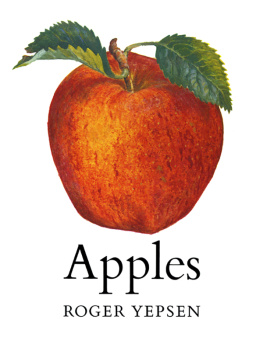
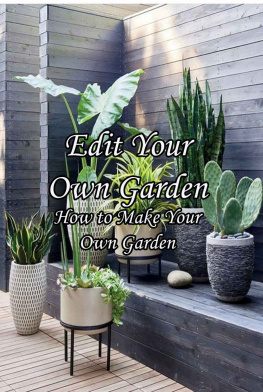
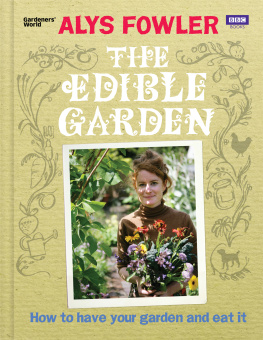
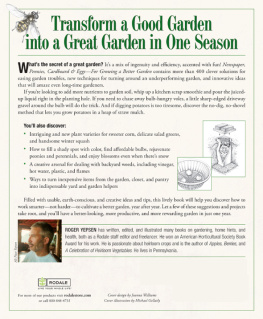
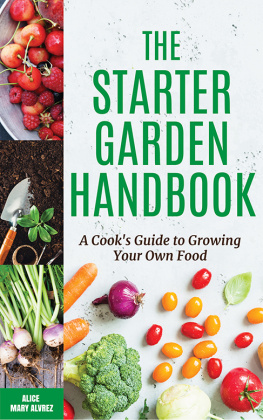


 , recycled paper
, recycled paper

 chapter 1, Seed Starting and Saving, tells how to enjoy the astounding variety of plants available only as seed, while saving money over buying plants. Starting from seed also allows you to plan for a midseason planting that will yield a late crop of vegetables or flush of flowers, at a time of year when nurseries are running out of stock and gardeners tend to run out of enthusiasm. And youll save substantially over what youd spend for plants.
chapter 1, Seed Starting and Saving, tells how to enjoy the astounding variety of plants available only as seed, while saving money over buying plants. Starting from seed also allows you to plan for a midseason planting that will yield a late crop of vegetables or flush of flowers, at a time of year when nurseries are running out of stock and gardeners tend to run out of enthusiasm. And youll save substantially over what youd spend for plants. The most challenging stage in a young plants life is adapting to the great outdoors. Chapter 2, Planting and Transplanting, offers approaches for easing this transition. Tips include using colored mulches that researchers have found to boost plant performance; gardening with elevated beds to bring the plants up to your level, rather than the other way around; and succeeding with inexpensive bare-root plants.
The most challenging stage in a young plants life is adapting to the great outdoors. Chapter 2, Planting and Transplanting, offers approaches for easing this transition. Tips include using colored mulches that researchers have found to boost plant performance; gardening with elevated beds to bring the plants up to your level, rather than the other way around; and succeeding with inexpensive bare-root plants. Turn to Chapter 3, Soil, Compost, and Fertilizing, for ideas on making the most of the organic gardeners greatest ally, good soil. Compost, proper pH, nutrients, and custom fertilizer blends.
Turn to Chapter 3, Soil, Compost, and Fertilizing, for ideas on making the most of the organic gardeners greatest ally, good soil. Compost, proper pH, nutrients, and custom fertilizer blends. Weeds happen, unless you are growing fungi in a cave, and Chapter 4, Weeds and What to Do about Them, shows how to meet this challenge with a creative arsenal that includes vinegar, hot water, flames, stone pavers, and sheets of transparent plastic.
Weeds happen, unless you are growing fungi in a cave, and Chapter 4, Weeds and What to Do about Them, shows how to meet this challenge with a creative arsenal that includes vinegar, hot water, flames, stone pavers, and sheets of transparent plastic. Chapter 5, Getting a Leg Up on Pests and Diseases, tells how to deal with everything from troublesome microbes to deer capable of leaping a 6-foot fence. The list of gardeners resources for this battle is long and growing, and includes row covers, natural pesticides, a remarkable number of beneficial insects and organisms, and even (your budget willing) high-tech robots.
Chapter 5, Getting a Leg Up on Pests and Diseases, tells how to deal with everything from troublesome microbes to deer capable of leaping a 6-foot fence. The list of gardeners resources for this battle is long and growing, and includes row covers, natural pesticides, a remarkable number of beneficial insects and organisms, and even (your budget willing) high-tech robots. When planning next years garden, you should consider your needs as well as those of your plants, advises Chapter 6, The Vegetable Plot. Youll read how to take best advantage of everything your particular site has to offer, while including a few amenities for yourselfa bit of shade, a bench, and paths that feel comfortable underfoot even after a couple of hours in the garden.
When planning next years garden, you should consider your needs as well as those of your plants, advises Chapter 6, The Vegetable Plot. Youll read how to take best advantage of everything your particular site has to offer, while including a few amenities for yourselfa bit of shade, a bench, and paths that feel comfortable underfoot even after a couple of hours in the garden. Herbs combine fragrance, flavor, and flowers, as well as attracting certain beneficial insects and repelling certain pests. Chapter 8, Growing and Enjoying Herbs, gathers a potpourri of pointers on having these talented plants play a bigger role in the garden and landscape.
Herbs combine fragrance, flavor, and flowers, as well as attracting certain beneficial insects and repelling certain pests. Chapter 8, Growing and Enjoying Herbs, gathers a potpourri of pointers on having these talented plants play a bigger role in the garden and landscape.